GRAPE EXPECTATIONS
Hello Vanessa
A few days ago was the perfect day for planting the Vanessa grape vine deposited here by the UPS guy. Not because the weather was warm and sunny or because working outdoors was made all the more pleasant with peach, pear, and plum trees in all their glory, awash in white or pink blossoms. And not because the plums were suffusing the air with a most delectable fragrance.
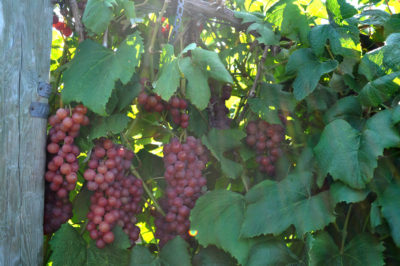
Vanessa grape
The day was perfect for planting because the soil was in such good tilth. With each shovelful, clumps of soil broke apart under their own weight. A far cry from decades ago in my first garden, around this time of year, when digging brought up clods of Wisconsin soil still sticky and wet.
In wet soil, digging drives air out of the soil; under such conditions, roots of trees, shrubs, vines, and seedlings suffer. Better to wait for the soil to dry before planting. But not too long. Soil that is too dry turns rock-hard, too hard to crumble into small pieces to sift amongst roots. All this is moot in sandy soils, which never hold enough water to make them too wet for planting. 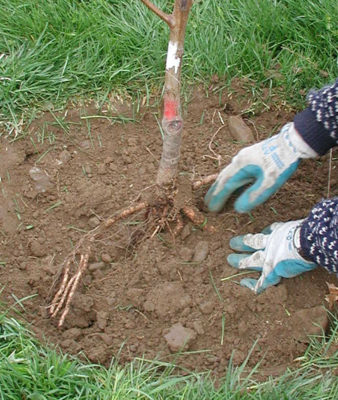
My present ground is a clay loam, which could be poor for planting if too wet. It wasn’t, because, first of all, it hadn’t rained for a few days. Second, warm weather had warmed the soil, the warmth speeding downward movement of excess water. And third, years and years of mulching with leaves, hay, and compost had made the ground rich in organic matter whose goodness had worked its way down through the soil profile with the help of earthworms and other soil organisms, rain, and the action of alternate freezing and thawing. Organic matter, among other benefits, acts as a glue to aggregate soil particles into a crystalline-like structure that helps with holding both air and water.
Training And Pruning Plans
I can bank on Vanessa growing well her first season in the ground. Soon after she arrived, bare-root, I had her roots plumping up with a day-long soak in water. Her planting hole was just deep enough to let her sit at the same depth as in the nursery, and one-and-a-half to twice the spread of the roots across. I clipped back a couple of long, straggly roots.
Holding the stem with one hand, I pushed the soil I had dug out of the hole back in amongst the roots, working it in with my fingertips after initially sifting soil in among the smaller roots by bouncing the plant up and down a little. With the roots nestled into their planting hole, I sprinkled a couple of gallons of water to further settle the soil and get the plant off to a good start.
She arrived with five strong-looking canes jutting up just above where her roots splayed out. Too many, for my purposes. Like her established neighbors, Vanessa will be trained to a “high wire double cordon spur pruned” system, a mouthful that sounds more complicated than it is. Two trunks will rise, unbranched, to about 6 feet in height to the middle wire of a five-wire trellis. One trunk will continue its journey horizontally along the middle wire in one direction; the extension of the other trunk will do likewise in the opposite direction. These two horizontal growths are permanent fixtures, called cordons (same root as the word “cord”). 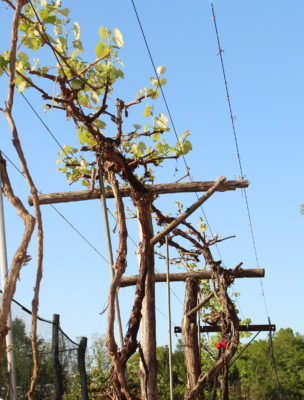
Grapes bear fruits on one-year old stems — these are the so-called “canes,” easily identified by their smooth, reddish brown bark and roughly pencil-thickness. New shoots growing from buds on canes bear bunches of grapes and can drape on the remaining wires on either side of the middle wire.
The following year, the new shoots become one-year-old canes. Without pruning (or with incorrect pruning), fruiting shoots and canes each year move further and further away from the cordon, so I cut each cane back to 2 buds in winter and, after a few years, cut them all the way back, to be replaced by new canes that are always popping out right from the cordon.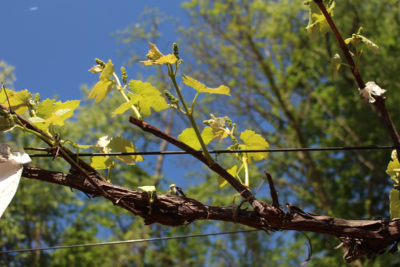
But all this is in Vanessa’s future. This year, all I want from her is two strong trunks.
Don’t Do What I Did
Rain fell, and I didn’t follow my own advice. Because I needed to convert a lumpy old garden area next door to lawn, and because lawngrass establishes best in cool weather, and because I had two helpers coming in a few days to help with ground preparation, I readied the area with a rototiller. I did so even though rain had been falling all day long. Rain fell even while I was tilling.
All in all, it was a horrible experience. Mud everywhere. Wrestling the tiller. Loud engine chugging away. (Now I remember one reason for my book, Weedless Gardening. Weed-less-ness comes, in part, from dispensing with tilling, which awakens buried weed seeds by exposing them to light. And there’s the added benefit of not having to till.)
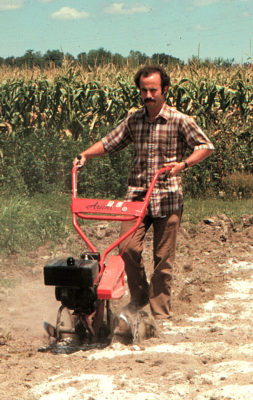
Youthful, foolish Lee, tilling
With good drainage, the job finally got done without excessive destruction of soil structure. And anyway, I was only planting lawngrass.

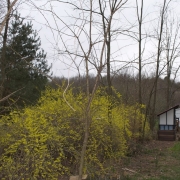
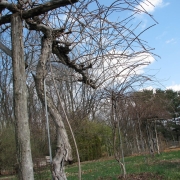

I always learn something here. The ground is horribly mucky here after 5-6″ of rain but there’s always a sunny side! I’m rooting for Vanessa!
I like the grapes sold in the grocery store. They are seedless and melt in your mouth. Are there any varieties like that which can be grown in New York State? Maybe Himrod or even Vanessa? I fear anything adapted to this part of the country will have tough chewy skins.
Yes, varieties like Vanessa, Himrod, Interlaken, and Romulus would be what you’re looking for.
I’ve been living in a house with a good backyard for four years, and since then, I have been learning so much about gardening, and I thank you for your role in it. There was a grape vine already here when I got the house. It never produced real grapes,but this year it is worse. They are getting black e dry before grow. I took some pictures, but I don’t know if or where I could put it here. Would you kindly tell me if I should finish this beautiful (abundant, very healthy, green canopy), and plant another vine? This Vanessa would do well in the 6th zone? (Arlington, VA, 22201)
Thank you very much for everything I learn from you.
Marilia
The grapes are getting black rot, a common disease. Control it with good pruning and siting so that the vines are bathed in sun and air. The disease overwinters on mummified berries, so clean those up also. Copper sprays, with timing and concentration according to label directions, also help.
Vanessa would do well in Zone 6.